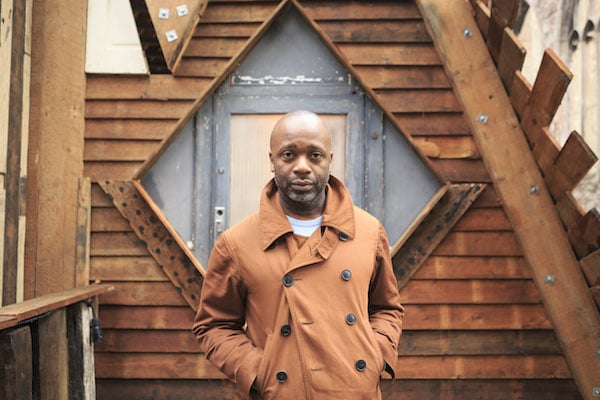
Photo: Max McClure
Theaster Gates opened his latest “city work”—and first public project in the UK—in Bristol last Thursday, launching nearly a month of continuous performances celebrating the sounds of the city and its diverse population.
Gates’s project, entitled Sanctum, is a collaboration with Bristol 2015 European Green Capital cultural programme and arts producers Situations. The piece unfolds inside Temple Church, a 14th century church containing 12th century ruins which was bombed during World War II. Gates built a structure inside the ruins with repurposed local bricks, wood which had been part of an old sugar warehouse, and a wall of Georgian windows. The site, erected in just 10 days with the help of local boat builders, is now host to 552 hours of continuous musical and spoken work performance.
Bristol is a city like Chicago, in some ways. It has a strong links to colonialism, the sugar trade, and slavery, plus strong black and creative communities and a history of industry. The unpublished schedule is broad, from the Bristol Pipes and Drums band—which kicked off the event—to Dubstep, punk, and spoken word acts. The performances, overlapping both literally and metaphorically, represent the sound of Bristol as it is today.
artnet News met Gates in Bristol to find out more about Sanctum and how things are going back in Chicago.
Sanctum by day
Photo: Max McClure
Do you see a relationship between Bristol and Chicago?
There is absolutely a relationship. I think that cities that have an industrial or manufacturing past are all tainted with preoccupations with greed, the creation of monopolies, and the exploitation of labor. In a way our cities, whether they are American or European, have those in common. The thing that is more interesting for me is: what does resilience look like in the face of the collapse of those monopolistic giants? What happens to the people who choose to stay in a city that has seen its best days after those days are gone?
In these in-between stages, you find that people have been doing these amazing things all along, and often those things are happening in the crevices, and the quiet places, and not amplified enough. In the same way that I knew there were amazing talents and riches in my neighborhood in Chicago, I knew that if we scratched the surface of Bristol, amazing things would emerge, there was no doubt. Amazing things happen as a result of the complicated histories of a place like this.
Crowds gathering at Sanctum.
Photo: Max McClure
There is that constant push and pull within British culture.
Yes, I think with the music [here], there is this regeneration and this kind of complicated fusion of cultures that make the music what it is. I am so happy that Sanctum can be a platform where these kinds of voices can be heard by new ears, and by each other.
The Bristol Pipes and Drums, who opened Sanctum
Photo: Max McClure
Do you feel like Sanctum is similar to what you are working with at Stony Island Art Bank in Chicago?
It does remind me of that, yes. In this moment, in my practice, I am making this more ambitious city work. My city work is not just the creation of a building, it’s also—once the vessel is made—what do you fill it with and who are the people who help you fill it, and what kind of consciousness do they need to have in order to make this a robust and complicated mix?
It takes a tremendous amount of commitment to have 552 hours of programming running for over three weeks. So this project, from the very beginning, is not a Theaster Gates project alone, it’s a city of Bristol project. I think there is something great about how I get to kind of disappear, that I don’t have any big words, I don’t have to sing a solo. I’ve done my work in a way, and now I’m very excited about how the city of Bristol gets to do its work and how they are bringing their game.
Sanctum is located inside the bombed out ruins of a 14th Century Church.
Photo: Max McClure
Do you think the elements of the past that you use in your work are offering up a possible future?
Absolutely. Yes, the materials are loaded, but I am ambivalent about their histories. We needed a sacred space, and there were wooden boards available. I’m more interested in the future of the sacred space, and if it’s built on a history of black exploitation… all the better. But, also, if we can reclaim those boards and use them to elevate practices that would not usually be seen, then fantastic!
Do you ever think, when you are making collaborative work like these city projects, “I just want to be in the studio, making work”?
No. I think it’s a different muscle. It’s like one work feeds the other. When I make this work, yes, it makes me miss the studio. But when I’m in the studio, I miss this work. It’s good because they really do feed each other and nurture each other in these amazing ways.
What’s next?
[Laughs] Can I stop? Can I rest? I think I’m going to go back home and ensure that the work that we started there matures. It’s a good moment. I’m thinking about the Arts Bank for the next couple of years, and I’m writing a book about the glass lantern slides that I just started. There’s been a lot of recent output, and I think it’s a good time for me to start quietly reflecting on all the things I’ve been doing.
You can watch a teaser of Sanctum here:
Sanctum runs 24 hours a day at Temple Church until November 21